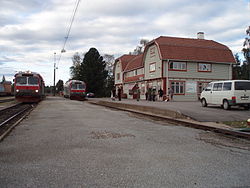Sveg
Sveg | |
|---|---|
 Sveg railway station | |
| Country | Sweden |
| Province | Härjedalen |
| County | Jämtland County |
| Municipality | Härjedalen Municipality |
| Area | |
| • Total | 2.85 km2 (1.10 sq mi) |
| Population (31 December 2010)[1] | |
| • Total | 2,547 |
| • Density | 895/km2 (2,320/sq mi) |
| Time zone | UTC+1 (CET) |
| • Summer (DST) | UTC+2 (CEST) |
Sveg is a locality and the seat of Härjedalen Municipality in Jämtland County, Sweden with 2,547 inhabitants in 2010.[1]
The Swedish author Henning Mankell was brought up in Sveg, and it is the setting for his crime novel Danslärarens återkomst (The Return of the Dancing Master).
Climate
Sveg has a relatively mild subarctic climate.[2] It has certain continental features, being prone to heat and cold extremes with an all-time record of 36 °C (97 °F) and a cold extreme of −43 °C (−45 °F), although the latter was set in the 19th century.[3] A more recent reading was −42.6 °C (−44.7 °F) in January 1987 during a chilling cold wave that struck Northern Europe. In spite of it being in the middle of the Scandinavian landmass on such a high parallel, the winters are somewhat milder than expected, due to the mild North Atlantic air that often rises temperatures. Summer days are often warm, many times averaging around 20 °C (68 °F), but nights are regularly cool, and frost can be recorded even in the midst of summer. In terms of Scandinavian climate, Sveg is an anomaly in that December is somewhat colder than February.
| Climate data for Sveg 2002-2014; extremes since 1901 | |||||||||||||
|---|---|---|---|---|---|---|---|---|---|---|---|---|---|
| Month | Jan | Feb | Mar | Apr | May | Jun | Jul | Aug | Sep | Oct | Nov | Dec | Year |
| Record high °C (°F) | 10.0 (50.0) |
10.0 (50.0) |
16.0 (60.8) |
22.5 (72.5) |
27.6 (81.7) |
35.0 (95.0) |
36.0 (96.8) |
33.0 (91.4) |
27.4 (81.3) |
21.9 (71.4) |
13.5 (56.3) |
8.5 (47.3) |
36.0 (96.8) |
| Mean daily maximum °C (°F) | −4.0 (24.8) |
−2.7 (27.1) |
2.1 (35.8) |
8.5 (47.3) |
13.1 (55.6) |
18.0 (64.4) |
21.1 (70.0) |
18.8 (65.8) |
13.6 (56.5) |
6.0 (42.8) |
0.7 (33.3) |
−2.9 (26.8) |
7.6 (45.7) |
| Mean daily minimum °C (°F) | −11.0 (12.2) |
−10.2 (13.6) |
−7.1 (19.2) |
−1.7 (28.9) |
2.8 (37.0) |
6.9 (44.4) |
9.9 (49.8) |
8.6 (47.5) |
4.4 (39.9) |
−0.6 (30.9) |
−5.1 (22.8) |
−10.4 (13.3) |
−1.1 (30.0) |
| Record low °C (°F) | −42.6 (−44.7) |
−39.8 (−39.6) |
−38.0 (−36.4) |
−27.0 (−16.6) |
−12.5 (9.5) |
−8.0 (17.6) |
−3.0 (26.6) |
−5.7 (21.7) |
−10.5 (13.1) |
−25.9 (−14.6) |
−33.0 (−27.4) |
−41.0 (−41.8) |
−42.6 (−44.7) |
| Average precipitation mm (inches) | 37.1 (1.46) |
29.3 (1.15) |
31.3 (1.23) |
37.6 (1.48) |
46.2 (1.82) |
64.3 (2.53) |
87.8 (3.46) |
69.2 (2.72) |
65.2 (2.57) |
45.1 (1.78) |
46.1 (1.81) |
43.6 (1.72) |
602.5 (23.72) |
| Source 1: SMHI precipitation average 1961-1990[4] | |||||||||||||
| Source 2: SMHI climate data 2002-2014[5] | |||||||||||||
Sports
The following sports clubs are located in Sveg:
See also
References
- ^ a b c "Tätorternas landareal, folkmängd och invånare per km2 2005 och 2010" (in Swedish). Statistics Sweden. 14 December 2011. Archived from the original on 10 January 2012. Retrieved 10 January 2012.
{{cite web}}: Unknown parameter|deadurl=ignored (|url-status=suggested) (help) - ^ "Sveg, Sweden Climate Summary". Weatherbase. Retrieved 30 April 2015.
- ^ "Hur var vädret?". SMHI. Retrieved 30 April 2015.
- ^ "SMHI Precipitation Averages 1961-1990". Swedish Metereological and Hydrological Institute (Sveg code 12 402).
- ^ "SMHI Monthly Statistics". SMHI. April 30, 2015.
External links
![]() Media related to Sveg at Wikimedia Commons
Media related to Sveg at Wikimedia Commons
